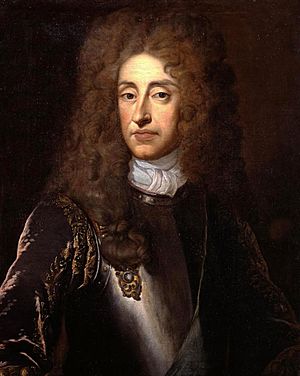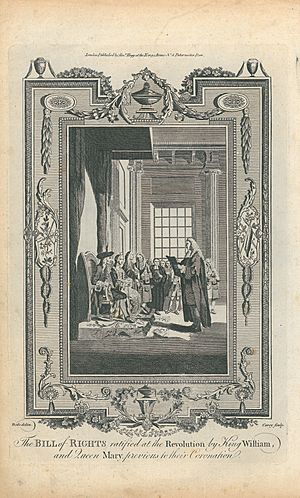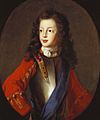Glorious Revolution facts for kids
The Glorious Revolution was a big event in the history of England and Scotland in 1688. People in England and Scotland were unhappy with their Catholic king, King James II. He didn't let them vote or choose their own religion. Because of this, they invited a Protestant leader, William III of Orange-Nassau, to become their new king.
William was King James II's nephew and also his son-in-law, as he was married to James's daughter, Queen Mary. William and Mary came to England. King James II was allowed to escape, and he went to France because he was afraid. William then signed the Bill of Rights, and England became a constitutional monarchy. This meant the king's power was limited by laws.
Contents
Why Did the Glorious Revolution Happen?
This story is partly about religion, but it's also about who had more power: the king or the Parliament. Years before, a civil war had happened because King Charles I tried to rule with total power, like an absolute monarch. His son, Charles II, was allowed to become king again only after he agreed to limit his powers.
However, Charles II's brother, James II, wanted to bring back the absolute power that their father, Charles I, had tried to have.
King James II's Actions
When King Charles II died in 1685 without any children who could legally inherit the throne, his brother, the Duke of York, became King James II in England and Ireland. He was also King James VII in Scotland.
King James II tried to give freedom of religion to people who were not part of the Church of England. He did this by saying that some laws passed by Parliament were no longer valid. Many people didn't like this. Some Protestant leaders and noblemen started talking to William, Mary's husband, as early as 1687.
In May 1688, James forced Anglican church leaders to read something called the Declaration of Indulgence. This declaration said that people who didn't agree with the Church of England could have religious freedom. This made King James even less popular.
Fears About a Catholic Heir
Protestants became even more worried in June 1688. This was when James's wife, Mary of Modena, gave birth to a son, James Francis Edward. People were scared because this son, unlike James's daughters Mary and Anne, would be raised as a Roman Catholic.
Some people even spread a rumor that the baby had been secretly brought into the Queen's room in a bed-warming pan, replacing a baby who had died. There was no real proof for this story. However, Mary, King James's daughter, publicly said she doubted if the boy was truly her father's son. She even sent a list of suspicious questions to her sister, Anne, about the baby's birth.
How William and Mary Took the Throne
On June 30, a group of seven important English leaders, known as the Immortal Seven, secretly asked William to come to England with an army. William was in the Netherlands with Mary at the time.
William was a bit unsure at first because he was jealous of Mary's position and power. But Mary told him she didn't care about political power. She said she would be "no more but his wife" and would do everything to make him king for life.
William's Invasion
William agreed to attack. He announced that James's newborn son was a "pretended Prince of Wales" (meaning not the real one). He also listed what the English people wanted. He said he only wanted a "free and lawful Parliament assembled" (meaning a fair Parliament to meet).
The Dutch army, which had been turned back by a storm in October, finally landed on November 5. The English Army and Navy then joined William's side. At this point, the English people had lost trust in King James. They didn't even try to help him.
On December 11, King James tried to run away but failed. He tried again on December 23, and this time he succeeded. James escaped to France and lived there in exile until he died.
Mary's Sadness and William's Ambition
Mary was sad about her father being removed from the throne. However, William told her to look happy when they arrived in London. Because of this, people thought she was being cold towards her father. King James also believed his daughter was disloyal to him, which deeply hurt Mary.
In 1689, a special Parliament, called the Convention Parliament, met to decide what to do. William of Orange felt uneasy about his position. He wanted to rule as a king, not just as the husband of a queen. The only example of a king and queen ruling together was from the 1500s. That was Queen Mary I and the Spanish Prince Philip. When they married, Philip became king, but only while his wife was alive, and he didn't have much power. William wanted to remain king even after Mary's death. Some important people suggested making Mary the only ruler, but Mary, who was loyal to her husband, refused.
New Laws and New Rulers
On February 13, 1689, Parliament passed the Declaration of Right. This declaration stated that James, by trying to run away on December 11, 1688, had "abandoned" (left) the government. This meant there was no king at the time. Normally, James's oldest son, James Francis Edward, would have been the next in line.
However, Parliament offered the crown to William and Mary as joint Sovereigns (rulers) instead. They added that "The sole and full exercise of the regal (royal) power be only in and executed by the said Prince of Orange in the names of the said Prince and Princess during their joint lives." This meant William would have the main power while they both lived. The declaration was later changed to exclude all Catholics from ever becoming king or queen. This was because it was "inconsistent" (not right) for a Protestant country to be ruled by a Catholic prince.
Coronation and Scottish Crown
William and Mary were crowned together at Westminster Abbey on April 11, 1689. The Archbishop of Canterbury usually performs coronations. But William Sancroft, the Archbishop at that time, felt that removing James II had been wrong. So, the Bishop of London, Henry Compton, crowned them instead.
On the day of the Coronation, the Convention of the Estates of Scotland finally declared that James was no longer King of Scotland. William and Mary were offered the separate Scottish Crown. This was because England and Scotland were not fully united until the Acts of Union in 1707. They accepted the Scottish Crown on May 11.
Even after this, some people in Scotland still strongly supported James. John Graham of Clevehouse, the Viscount of Dundee, gathered an army and won a battle at Killiecrankie on July 27. But Dundee's army lost many soldiers, and he was badly hurt at the start of the battle. This stopped the main resistance to William, and the rebellion was quickly put down. The next month, there was a big defeat for James's supporters at the Battle of Dunkeld.
Images for kids
-
The Seven Bishops who were put on trial in 1688.
-
James Francis Edward Stuart, around 1703; his birth made people fear a Catholic royal family.
-
William III, King of England, Scotland and Ireland.
-
Henry Sydney, who wrote the secret invitation to William.
-
Admiral Dartmouth, who spent more time watching his disloyal captains than planning battles.
-
Lord Danby; one of the Immortal Seven and William's helper in Northern England.
-
William landed at Torbay, a sheltered place with mild weather.
-
John Churchill, around 1685; a close friend of James, his leaving to join William was a big blow.
-
William III and Mary II ruled together until Mary's death in 1694.
-
Parliament House, where the Scottish leaders met in March 1689.
See also
 In Spanish: Revolución Gloriosa para niños
In Spanish: Revolución Gloriosa para niños




















